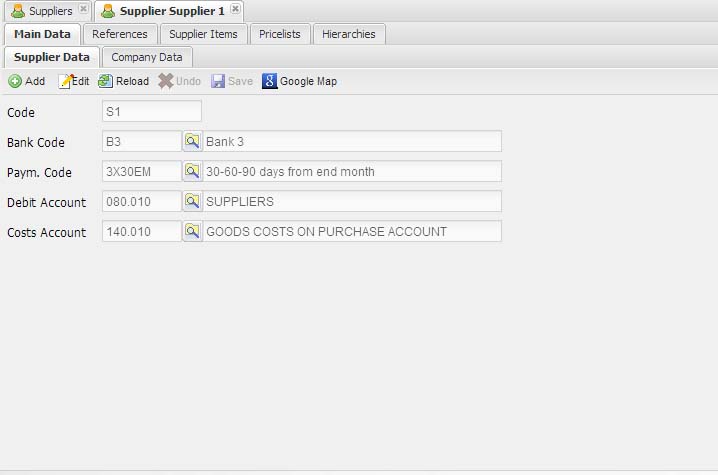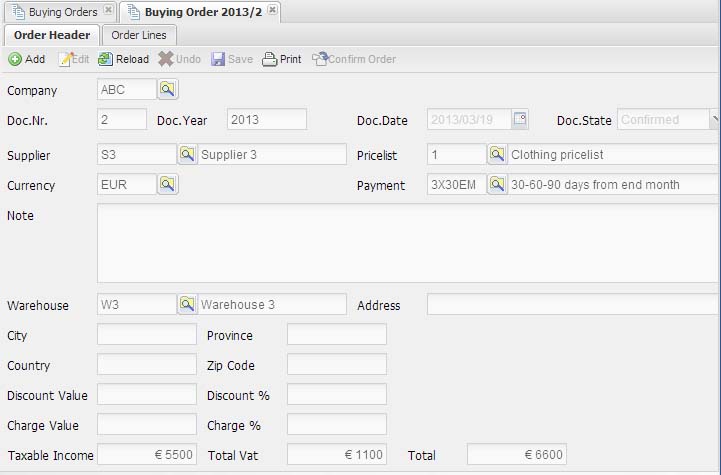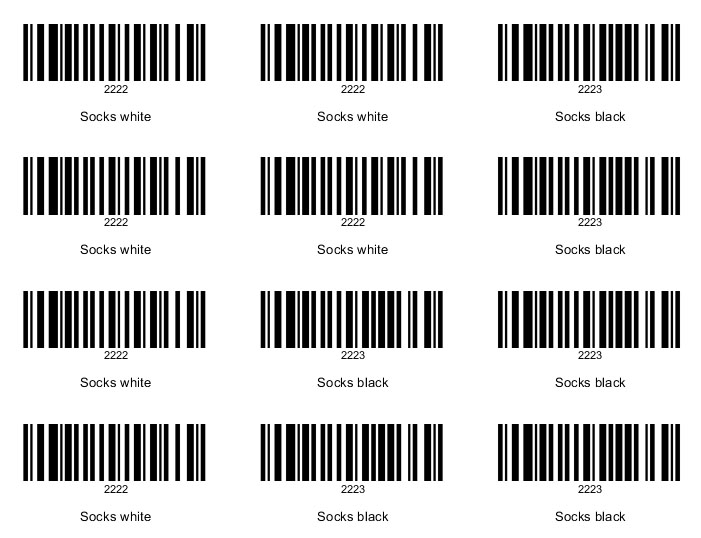| Home | SourceForge.net |More documentation |
| Project Page |
| Documentation |
| Download |
| Installation Info |
| Tickets |
| Public forums |
Procurement
JAllInOneWeb flow of supply guarantees the integrity and homogeneity of the entire process: each document in the supply process is based on data defined in the previous document, therefore avoiding repetitive introduction of data and human errors.
It is possible in this way to create different documents related to the same flow (purchase order, entry inward, passive invoice, payments) and manage them according to their document state (opened, confirmed, closed, etc).
Supply process is integrated with accounting and payment dues to guarantee an up to date and reliable data for the finance department
|
Suppliers definition includes the definition of related data: bank, default payment, accounts to use to record in accounting debits and costs. The same form includes the definition of references, links to supplier hierarchies and supplier pricelists.
It is possible also to define a purchase price valid for a specific interval of dates and for a specific supplier and supplier pricelist.
Optionally, if the item has subvariants/variants, then it is possible to define a supplier price at a more detailed level than the item level: it is possible to associate a price for a specific combination of variants: if a supplier price is defined at a more detailed level, then this price is used in purchase order instead of the default price defined at item level and inherits from this one the same validity interval, which can be defined only at item/supplier pricelist level.
In order to simplify the definition of the same price for all values that a variant can assume (for instance: the same price for all variants combinations fixed the XXL size), several buttons are provided, one for each variant
|
In a buying order header, the user has to define the supplier, warehouse where loading ordered items , pricelist and payment conditions.
When the order is completed, a confirmation button is provided in order to confirm the order. After the order confirmation, an in delivery note can be created, in order to process the items provided by the supplier. When all items have been loaded in the warehouse, the order state changes from confirmed to closed.
|
It is also available a "print barcode labels" for a purchase order: by means of this button it is possible to print barcodes associated to the items specified in the order; this feature is useful when ordered items arrive in the warehouse: a barcode label can be applied to each item. in order to identity it within the warehouse.
|
A buying order allows to define a list of items. When adding an item it is possible to define discounts expressed as percentage or value. The same form allows to define header discounts and charges, both expressed as percentage or value. A report is available to print the order. That document can be confirmed to block further changes and to allow the delivery note creation: in this state the order is considered a confirmed order.

As for sale documents, a purchase order allows to specify items and item variants: when specifying an item, if the item supports variants, then a variants matrix is showed and the user can specify multiple quantities for the desired variants combinations; prices are determined according to the item variants: if a price was defined for that variants combination, then this unit price is proposed instead of the one defined at item level, for pricelist selected in the purchase header.
Several purchase invoices are available: immediate, from delivery note, from purchase document. Debit notes are provided too.
A report is available to print the invoice.
A due register functionality is provided to show, search and manage payment dues.
Reording process and minimum stocks
Within the item detail frame, it is possible to define the minimum stock of an item. This quantity is useful in the process of reording items.
JAllInOneWeb provides two functionalities useful to simplify the decision process of which items to reorder: ABC classification and reordering from minimum stocks.
ABC classification allows to partition items available in a speciific warehouse in three bands named A, B and C. According to Pareto principle, a few items have an high value and most items have a low value. That value can be misured using two dimensions: the unsold quantity of an item (i.e. quantity available in the warehouse minus the quantity pawned in some sale document) and the invoiced quantity of item in all sales documents in a specific interval of time. By matching items using these two dimensions, it is possible to classify each item of a specific warehouse, so that an item is classified as belonging to band A or B or C in the dimension of the unsold items and as belonging to the band A or B or C in the dimension of invoiced items. Using ABC classification based on the matching among unsold quantities and invoiced, it is therefore possible to identify which items have high unsold quantities and low invoiced, low unsold quantities and high invoiced and so on.
The outcome of the ABC classification is to support the user in the decision process of which minimum stocks to define for items, for instance by reducing the min stocks for items having high unsold quantities and low invoiced.
|
The next step is to create purchase orders, in order to supply a warehouse. The items reorder fucntionality allows to create one or more purchase orders, starting from the list of items having a minimum stocks defined. The proposed items are retrived from the ones having a minimum stocks defined and beloging to the pricelist of some supplier; the filter panel allows to define a preferred supplier to use; anyway if an item is not included in any pricelist of the preferred supplier, another supplier is proposed, by selecting the one having the lower price of the same item.
The list of items includes also the available quantity of each item in the specified warehouse, the quantity pawned by some sale document (order or contract in confirmed state), the future quanity (i.e. the quantity specified in some purchase order having a confirmed state), etc.
A user can select one or more rows and for each one confirm the proposed quantity or chanhe it to another value. Finally it can create a list of purchase orders using the "Create orders" buttons. A distinct purchase order is created for each combination of supplier/pricelist. After the creation of orders, the user can change each order before confirming it, for instance to change the delivery date or change some other data.
|





